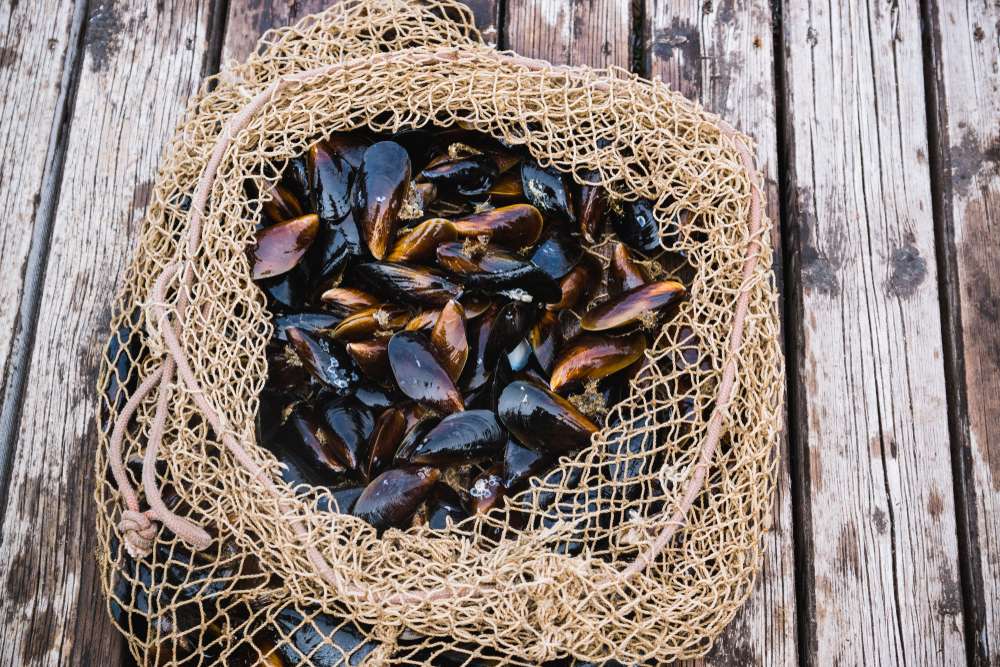Over 500 aquatic species are farmed around the world, making aquaculture an extraordinarily diverse form of food production, responsible for a huge range of seafood products, many of which are traded internationally. In Western Europe some of the most widely farmed – and popular to consume – species include Atlantic salmon and mussels: species that can be grown in similarly temperate locations.
In Europe, the main Atlantic salmon producing countries are Norway, Scotland, the Faroe Islands, Iceland and Ireland. While in the rest of the world Chile, Canada and Australia also produce significant volumes. Regardless of the country the farms are located in, most of the salmon are initially raised in indoor hatcheries, before being transferred to circular net pens in cool coastal waters, where they are grown to harvest size of around 5 kg apiece. There’s a growing trend to grow the salmon indoors for longer, in order to ensure they are ready for the rigours of marine life prior to transfer.

Land-based and offshore opportunities
Interestingly, this development has coincided with – and helped to pave the way for – the rise of raising salmon to market size entirely in land-based farms. In these high-tech indoor facilities environmental parameters – including the water temperature and oxygen levels – can be tightly controlled. Many of these indoor farms are equipped with recirculating aquaculture systems (RASs), which minimise the amount of water required. This means that Atlantic salmon can now be farmed in small volumes in some unlikely places, close to key markets. Indeed, salmon farms are already operational in Miami and Poland, for example, and many more are currently under construction or being planned in places including Ostend, in Belgium.
Another interesting trend in the salmon farming sector is the move away from sheltered coastal waters to more exposed, offshore sites, where new technologies are being developed that are capable of withstanding the sometimes harsh environmental conditions. Adapting techniques pioneered in the oil and gas industry, these vast metal offshore farming systems might offer another means for the industry to expand from its current volume of around 2.3 million tonnes a year to meet the ever-increasing demand, as there are few opportunities for it to grow further in fjordic settings, where competition for coastal resources is more intense.
The world’s most sustainable seafood?
Mussel farming is widely seen as one of the most environmentally friendly forms of food production on the planet. Juvenile mussels naturally attach themselves to ropes left in suitable locations in the spring and will grow to market size without the need for supplementary feed – filter feeding on naturally occurring plankton instead. Mussel farms can increase biodiversity as the lines trailing down from floats provide three-dimensional structures which a range of aquatic species can colonise. They also help remove excess nitrogen from seawater, as well as converting atmospheric carbon dioxide into the calcium carbonate that makes up their shells.
Blue mussels and Mediterranean mussels are the most commonly consumed mussel species in Europe and the key producing countries include Spain, the UK and the Netherlands. Other popular species include the Chilean mussel and the green-lipped mussel, which are farmed in large quantities in Chile and New Zealand respectively.
Like in the salmon sector, mussel farming companies are looking towards opportunities to operate further from the coast, where conditions are suitable and space at less of a premium. There are also a number of initiatives afoot to investigate the possibility of raising mussels alongside the expanding offshore renewables sector, with wind turbines potentially offering shelter for mussel lines in locations that might otherwise be too exposed.
A complementary approach
Intriguingly, there are also several experimental farming projects underway in which salmon and mussels are grown alongside each other in a system known as integrated multi-trophic aquaculture (IMTA). In IMTA systems the two species complement each other’s needs – with the mussels helping to improve the water quality for the salmon, while benefitting from any excess nutrients around the salmon farm, but this remains a niche field.
Given the growing global population, the limited availability of additional agricultural land and the hugely efficient feed conversion ratios of aquatic species aquaculture, it’s little surprise that aquaculture is growing by around 6 percent a year. While consumer demand will help to fuel the search for the expansion of the salmon sector – it will only be able to grow with the successful adoption of new technologies. Meanwhile, the growth of mussel aquaculture is largely dependent on more consumers coming to appreciate the sector’s unrivalled sustainability credentials, their health benefits and the ease of preparing these tasty shellfish.











Comments